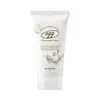What's inside
What's inside
 Key Ingredients
Key Ingredients

 Benefits
Benefits

 Concerns
Concerns

 Ingredients Side-by-side
Ingredients Side-by-side

Water
Skin ConditioningGlycerin
HumectantSodium Cocoyl Isethionate
CleansingDaucus Carota Sativa Root Extract 10%
Skin ConditioningPotassium Cocoyl Glycinate
Hydroxypropyl Starch Phosphate
1,2-Hexanediol
Skin ConditioningButylene Glycol
HumectantPotassium Cocoate
EmulsifyingPolyquaternium-67
Daucus Carota Sativa Root Powder
Skin ConditioningPogostemon Cablin Leaf Oil
MaskingEthylhexylglycerin
Skin ConditioningCitrus Aurantium Bergamia Fruit Oil
MaskingDisodium EDTA
Rosmarinus Officinalis Leaf Oil
MaskingPelargonium Graveolens Flower Oil
MaskingEucalyptus Globulus Leaf Oil
PerfumingAllantoin
Skin ConditioningCitric Acid
BufferingDaucus Carota Sativa Seed Oil
EmollientSqualane
EmollientSodium Hyaluronate
HumectantHydroxypropyltrimonium Hyaluronate
Hydrolyzed Hyaluronic Acid
HumectantSodium Acetylated Hyaluronate
HumectantHyaluronic Acid
HumectantHydrolyzed Sodium Hyaluronate
Skin ConditioningSodium Hyaluronate Crosspolymer
HumectantPotassium Hyaluronate
Skin ConditioningWater, Glycerin, Sodium Cocoyl Isethionate, Daucus Carota Sativa Root Extract 10%, Potassium Cocoyl Glycinate, Hydroxypropyl Starch Phosphate, 1,2-Hexanediol, Butylene Glycol, Potassium Cocoate, Polyquaternium-67, Daucus Carota Sativa Root Powder, Pogostemon Cablin Leaf Oil, Ethylhexylglycerin, Citrus Aurantium Bergamia Fruit Oil, Disodium EDTA, Rosmarinus Officinalis Leaf Oil, Pelargonium Graveolens Flower Oil, Eucalyptus Globulus Leaf Oil, Allantoin, Citric Acid, Daucus Carota Sativa Seed Oil, Squalane, Sodium Hyaluronate, Hydroxypropyltrimonium Hyaluronate, Hydrolyzed Hyaluronic Acid, Sodium Acetylated Hyaluronate, Hyaluronic Acid, Hydrolyzed Sodium Hyaluronate, Sodium Hyaluronate Crosspolymer, Potassium Hyaluronate
Water
Skin ConditioningMyristic Acid
CleansingGlycerin
HumectantPotassium Hydroxide
BufferingPalmitic Acid
EmollientStearic Acid
CleansingLauric Acid
CleansingSucrose
HumectantCocamidopropyl Betaine
CleansingOlea Europaea Fruit Oil
MaskingCetearyl Olivate
Polyglyceryl-10 Laurate
Skin ConditioningParfum
MaskingEgg Yolk Extract
EmulsifyingAlbumen Extract
EmollientSorbitan Olivate
EmulsifyingSodium Chloride
MaskingSolanum Lycopersicum Fruit Extract
AntioxidantGlycyrrhiza Glabra Root Extract
BleachingDaucus Carota Sativa Root Extract
Skin ConditioningCentella Asiatica Extract
CleansingCamellia Sinensis Leaf Extract
AntimicrobialDisodium EDTA
Butylene Glycol
HumectantDipotassium Glycyrrhizate
HumectantSalicylic Acid
MaskingArgania Spinosa Kernel Oil
EmollientPolysorbate 80
EmulsifyingPhenoxyethanol
PreservativeOleth-7
EmulsifyingSesamum Indicum Seed Oil
EmollientBeta-Sitosterol
Emulsion StabilisingSerenoa Serrulata Fruit Extract
Skin ConditioningSulfur
AntiseborrhoeicTocopherol
AntioxidantGlycine Soja Seed Extract
Skin ConditioningChamomilla Recutita Flower Extract
MaskingButylphenyl Methylpropional
PerfumingLinalool
PerfumingHydroxycitronellal
PerfumingWater, Myristic Acid, Glycerin, Potassium Hydroxide, Palmitic Acid, Stearic Acid, Lauric Acid, Sucrose, Cocamidopropyl Betaine, Olea Europaea Fruit Oil, Cetearyl Olivate, Polyglyceryl-10 Laurate, Parfum, Egg Yolk Extract, Albumen Extract, Sorbitan Olivate, Sodium Chloride, Solanum Lycopersicum Fruit Extract, Glycyrrhiza Glabra Root Extract, Daucus Carota Sativa Root Extract, Centella Asiatica Extract, Camellia Sinensis Leaf Extract, Disodium EDTA, Butylene Glycol, Dipotassium Glycyrrhizate, Salicylic Acid, Argania Spinosa Kernel Oil, Polysorbate 80, Phenoxyethanol, Oleth-7, Sesamum Indicum Seed Oil, Beta-Sitosterol, Serenoa Serrulata Fruit Extract, Sulfur, Tocopherol, Glycine Soja Seed Extract, Chamomilla Recutita Flower Extract, Butylphenyl Methylpropional, Linalool, Hydroxycitronellal
Ingredients Explained
These ingredients are found in both products.
Ingredients higher up in an ingredient list are typically present in a larger amount.
Butylene Glycol (or BG) is used within cosmetic products for a few different reasons:
Overall, Butylene Glycol is a safe and well-rounded ingredient that works well with other ingredients.
Though this ingredient works well with most skin types, some people with sensitive skin may experience a reaction such as allergic rashes, closed comedones, or itchiness.
Learn more about Butylene GlycolDaucus Carota Sativa Root Extract comes from the root commonly known as carrot (the orange kind we eat!).
This extract contains beta-carotene, a pigment responsible for giving plants the orange color. Beta-carotene is a potent antioxidant. Antioxidants may help reduce the signs of aging.
Beta-carotene is the reason we turn orange if we eat too many carrots.
It should be noted coming into contact with the leaves of wild carrots can cause skin irritation. The sap causes phytophotodermatitis, or sensitivity exposed to sunlight.
This ingredient is created using the edible parts of the carrot.
Learn more about Daucus Carota Sativa Root ExtractDisodium EDTA plays a role in making products more stable by aiding other preservatives.
It is a chelating agent, meaning it neutralizes metal ions that may be found in a product.
Disodium EDTA is a salt of edetic acid and is found to be safe in cosmetic ingredients.
Learn more about Disodium EDTAGlycerin is already naturally found in your skin. It helps moisturize and protect your skin.
A study from 2016 found glycerin to be more effective as a humectant than AHAs and hyaluronic acid.
As a humectant, it helps the skin stay hydrated by pulling moisture to your skin. The low molecular weight of glycerin allows it to pull moisture into the deeper layers of your skin.
Hydrated skin improves your skin barrier; Your skin barrier helps protect against irritants and bacteria.
Glycerin has also been found to have antimicrobial and antiviral properties. Due to these properties, glycerin is often used in wound and burn treatments.
In cosmetics, glycerin is usually derived from plants such as soybean or palm. However, it can also be sourced from animals, such as tallow or animal fat.
This ingredient is organic, colorless, odorless, and non-toxic.
Glycerin is the name for this ingredient in American English. British English uses Glycerol/Glycerine.
Learn more about GlycerinWater. It's the most common cosmetic ingredient of all. You'll usually see it at the top of ingredient lists, meaning that it makes up the largest part of the product.
So why is it so popular? Water most often acts as a solvent - this means that it helps dissolve other ingredients into the formulation.
You'll also recognize water as that liquid we all need to stay alive. If you see this, drink a glass of water. Stay hydrated!
Learn more about Water